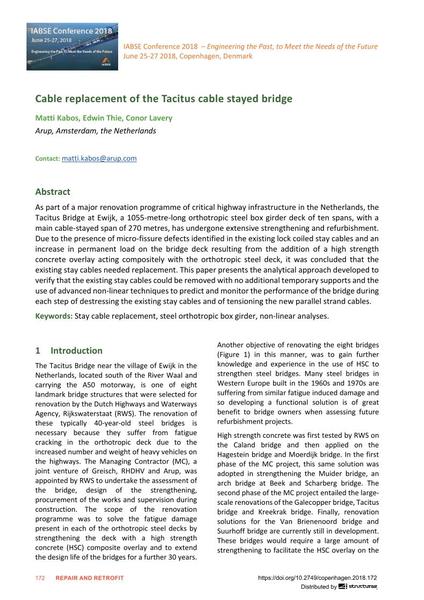Cable Replacement of the Tacitus Cable Stayed Bridge

|
|
|||||||||||
Détails bibliographiques
| Auteur(s): |
Matti Kabos
(Arup, Amsterdam, the Netherlands)
Edwin Thie (Arup, Amsterdam, the Netherlands) Conor Lavery (Arup, Amsterdam, the Netherlands) |
||||
|---|---|---|---|---|---|
| Médium: | papier de conférence | ||||
| Langue(s): | anglais | ||||
| Conférence: | IABSE Conference: Engineering the Past, to Meet the Needs of the Future, Copenhagen, Denmark, 25-27 June 2018 | ||||
| Publié dans: | IABSE Conference Copenhagen 2018 | ||||
|
|||||
| Page(s): | 172-179 | ||||
| Nombre total de pages (du PDF): | 8 | ||||
| DOI: | 10.2749/copenhagen.2018.172 | ||||
| Abstrait: | As part of a major renovation programme of critical highway infrastructure in the Netherlands, the Tacitus Bridge at Ewijk, a 1055-metre-long orthotropic steel box girder deck of ten spans, with a main cable-stayed span of 270 metres, has undergone extensive strengthening and refurbishment. Due to the presence of micro-fissure defects identified in the existing lock coiled stay cables and an increase in permanent load on the bridge deck resulting from the addition of a high strength concrete overlay acting compositely with the orthotropic steel deck, it was concluded that the existing stay cables needed replacement. This paper presents the analytical approach developed to verify that the existing stay cables could be removed with no additional temporary supports and the use of advanced non-linear techniques to predict and monitor the performance of the bridge during each step of destressing the existing stay cables and of tensioning the new parallel strand cables. | ||||
